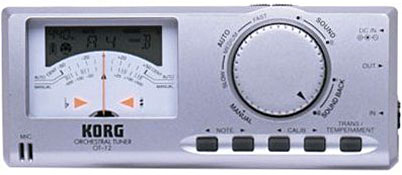  |
||
 |
 |
 |
 |
 |
||
| reference articles | competition journal | piping links | FAQ | contact me |
Andrew's Tips: Chris Hamilton on using the Korg OT-12 TunerChristopher Hamilton is a Professional Grade piper, a EUSPBA adjudicator, instructor, moderator at the BobDunsire.com forums. Below, Chris explains how to use the Korg OT-12 Orchestral Tuner to tune bagpipes. Korg OT-12 • Instructions for Pipe Band Tuningby Christopher Hamilton
The Korg OT-12 tuner, while not designed for bagpipes, can be used for tuning pipe band drones and 'Low A's quite effectively. Here is the method that I've developed over the past few years. Drones: 0. Select one bagpipe in the band to be the "master". All others will tune to this one. Once the chanter is well set, tune the drones of the master bagpipe ... by EAR. Make sure the drones are perfectly in tune with Low A. 1. Turn on the tuner using the Power button. 2. Set the dial to AUTO - Slow. This sampling rate tends to work best for drones. The meter can be used in either Bb or A modes. If you use Bb mode, it'll display the relative pitch. The standard frequency will read 440 Hertz (Hz), or cycles per second, at this point. This does not mean that B-flat is 440 Hz, but rather that the B-flat is relative to an A of 440 Hz. Therefore, the B-flat is 467 Hz. (this "+27" formula will tell you your absolute pitch of Low A with these things). It's easier with the extended range of this tuner to simply crank it up to the 470s using the "Calib" buttons and get the actual pitch. 3. Hold the meter up to the outside tenor of the well-tuned master pipe, and repeatedly push the left or right Calib buttons until the red sharp and flat LED lights are both on and steady and the analog needle is locked at 0 (zero) cents (the deviation from the selected pitch). The number displayed (say 476) is of the pitch of the Low A. 4. Tune the rest of the drones to this frequency. There are two ways to do it. First, you can go around while the whole band is playing and do all drones to the meter. In addition, you can have each piper blow up individually, tune their outside tenor to the meter, then tune the middle tenor and bass to the outside tenor by ear (can be much faster). I use both methods so that I'm constantly tuning drones regardless of what the P/M is doing. Note that there may be cases where the chanter does not "meet" the drones exactly. This can indicate a sharp or flat chanter, but minor variations are to be expected. A badly out-of-sync sound can point out a bad chanter. Make adjustments to the pitch as you play. On a hot day, expect to raise that pitch by several hertz as you get closer to competition time and the pipes get played in and the temperature affects them. Recheck the P/M for upward drift as you go. For best results, hold the meter vertically and to the side of the bush on top of the drone (ie, against the edge of the ring cap). This produces the least interference with the sound coming from the drone and allows the most accurate reading. Watch pipers on which the needle goes up and down while they're blowing. This is tough to tune to, but you've kind of got to take an "average" or "most common" reading. Unlike some older tuners, when you turn the power off, it "remembers" the last pitch you used and will display that as the standard when you turn it on again. Chanters: You can check the unison of the band Low A's by going around and, with the tuner already calibrated, holding it up to their chanter while the piper is playing Low A. Flat / sharp variations will be visible just as in drone tuning. Adjustments for sharpness or flatness can then be made to the reed. Opinion: The person(s) doing the tuning, in my opinion, should be pipers with a good ear themselves. The tuner is a supplement, an aid, and can be a disaster if used incorrectly. Also, make sure whoever is tuning is playing their own pipes enough so they're not going flat to the band, and has a known stable bagpipe. Thanks Chris!
Copyright © 2002 Tone Czar Bagpipes / Christopher Hamilton This page last updated Sunday, February 6, 2011 |
| sitemap | ||



